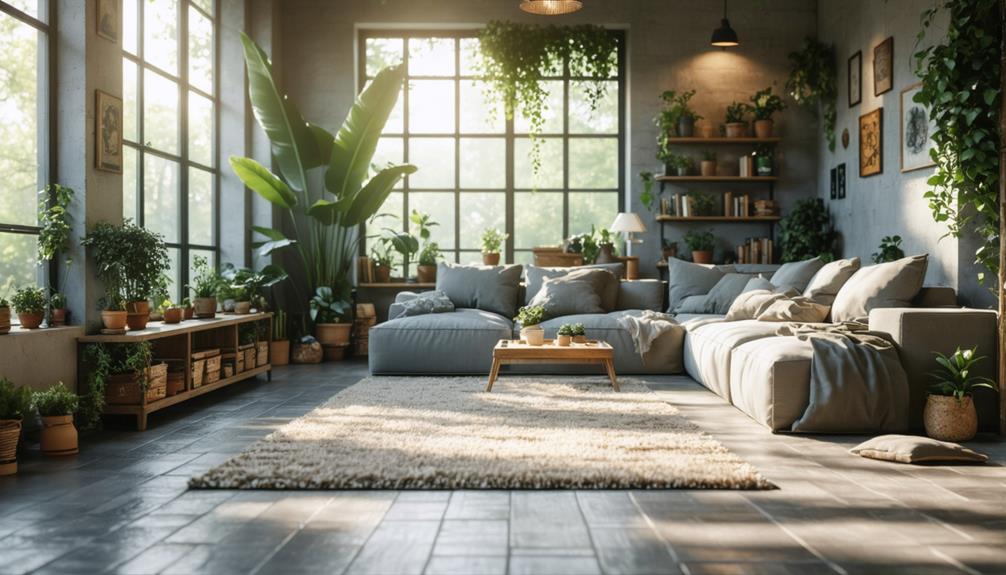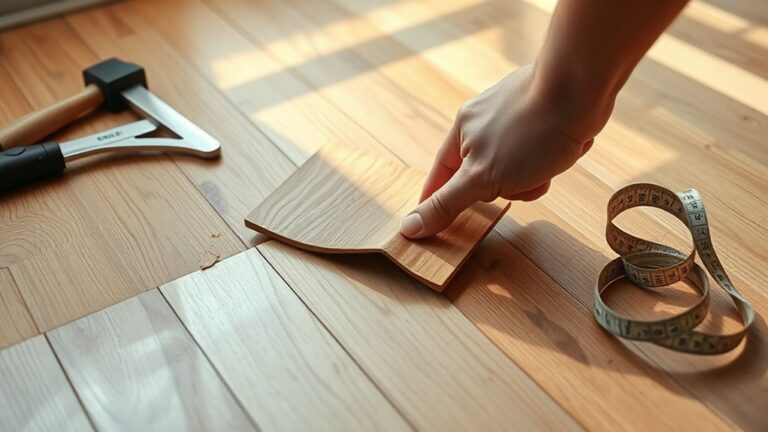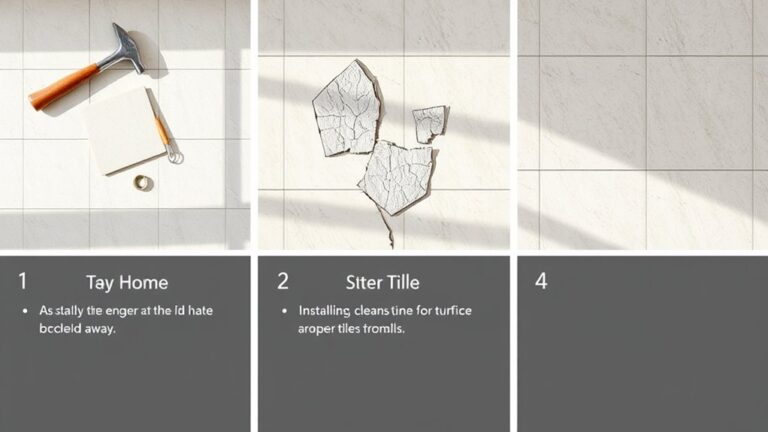For elderly households, choosing slip-resistant flooring is critical to reduce fall risks. Opt for materials like rubber and cork, which provide excellent traction and shock absorption. Luxury vinyl flooring is stylish yet low-maintenance, ideal for high-traffic areas. Avoid polished stones and area rugs, as they can create hazards. Low-pile carpeting offers warmth while minimizing trip risks. Guarantee easy-to-clean surfaces to maintain hygiene and safety. A seamless shift between flooring types helps prevent slips. These factors help enhance safety and independence in your home. Explore further to uncover additional flooring options and important installation tips.
Importance of Slip-Resistant Flooring
When it comes to creating a safe living space for elderly individuals, slip-resistant flooring stands out as a vital consideration. Falls are the leading cause of injuries among older adults, with one in four experiencing a fall annually. By prioritizing slip resistance in your flooring choices, you can greatly reduce the risk of falls, safeguarding your elderly loved one's health and enhancing their quality of life.
Flooring for the elderly should feature textured surfaces and non-slip options, especially in moisture-prone areas like bathrooms and kitchens where slips are more likely to occur. Implementing these materials not only aids in fall prevention but also supports the use of mobility aids, such as walkers or canes, by providing a stable surface for navigation.
Moreover, slip-resistant flooring can alleviate health concerns related to fall-related injuries, which often lead to increased healthcare costs. By investing in effective flooring solutions, you can contribute to a safer environment that minimizes the potential for accidents. Additionally, it is important to select flooring that's easy to clean and maintain, as this reduces the likelihood of spills that could lead to falls.
Ultimately, choosing slip-resistant flooring is not just about aesthetics; it is about creating a secure atmosphere where your elderly loved ones can enjoy their independence with confidence. Prioritizing safety through effective flooring choices can foster a sense of freedom and well-being in their daily lives.
Safety Considerations for Seniors
Creating a safe environment for seniors goes beyond just selecting slip-resistant flooring. While slip-resistant flooring is significant for preventing falls, it's important to evaluate additional safety features that enhance overall well-being. One notable aspect is cushioning. Flooring materials that offer cushioning can minimize the impact of falls, reducing the likelihood of serious injuries. This feature is particularly important as one in four older adults experiences a fall annually in the U.S.
Moreover, easy-to-clean flooring options play a key role in maintaining hygiene, which is especially critical in elderly households. Clean surfaces help reduce the risk of infections and illnesses, ensuring a healthier living environment. When choosing flooring, it's important to prioritize low-maintenance options. High-maintenance flooring can create a trip hazard, increasing the risk of falls as seniors navigate their homes.
Aesthetic appeal should never overshadow safety features. While you might want your home to look good, the primary goal should be functionality and slip resistance. Flooring that combines these elements not only provides safety but also supports the independence and freedom that seniors desire.
Flooring Types to Avoid
When selecting flooring for elderly households, certain types should be avoided due to their inherent risks. For instance, polished natural stone and high-gloss hardwood can become dangerously slippery, while ceramic tiles may present uneven surfaces that increase tripping hazards. Additionally, area rugs can shift and pose maintenance challenges, complicating safety for those with mobility issues.
Tripping Hazards Present
Certain flooring types can pose considerable tripping hazards for elderly individuals, particularly those who rely on mobility aids. To promote fall prevention and safety, it's vital to avoid the following flooring options:
- Area Rugs: They can easily slip or bunch up, creating tripping hazards.
- Polished Natural Stone: Extremely slippery when wet, increasing fall risk.
- Ceramic and Porcelain Tiles: Often have uneven surfaces and wide grout joints, leading to instability.
- High-Gloss Hardwood Floors: Visually appealing but prone to spills, making them slippery.
- Bamboo Flooring: Although eco-friendly, it's susceptible to moisture and scratches, especially in high-traffic areas.
Choosing slip-resistant flooring can greatly enhance safety for seniors and promote mobility. Opting for surfaces that have a textured finish or provide grip can help mitigate these tripping hazards. Making sure that flooring is level and consistent minimizes the likelihood of falls. By carefully considering the types of flooring in your home, you can create an environment that prioritizes safe surfaces, allowing for greater independence and movement for elderly individuals. Prioritizing these factors is essential for maintaining a safe living space.
Maintenance Challenges Ahead
Maintaining flooring in elderly households can be a challenging task, particularly with high-maintenance options that may not be suitable for everyone. Certain flooring types can create considerable maintenance challenges while compromising safety. For instance, area rugs might slide or bunch, resulting in tripping hazards, especially for seniors using mobility aids. Similarly, natural stone flooring can be slippery when wet, increasing the risk of falls.
Ceramic and porcelain tiles often present uneven surfaces and wide grout joints, making cleaning difficult and raising tripping concerns. Furthermore, polished hardwood requires regular upkeep that can be physically demanding, potentially leading to slips during cleaning. Flooring that features height differences, such as thresholds or steps, can further pose serious risks. Ensuring seamless shifts between different flooring types is vital to minimize falls and enhance safety.
In selecting flooring for elderly households, it's important to avoid these high-maintenance options that may lead to maintenance challenges. Prioritizing slip-resistant flooring with minimal upkeep can greatly reduce the risk of falls while providing a safer living environment for older adults.
Benefits of Rubber Flooring
While guaranteeing safety and comfort in elderly households is essential, rubber flooring stands out as an ideal solution. This flooring type has numerous benefits that address the unique needs of seniors, making it a top choice for enhancing their living spaces.
- Slip-resistant surface minimizes fall risks, even in wet conditions.
- Impact absorption properties provide comfort and reduce joint strain.
- Durability allows it to withstand heavy foot traffic, ideal for busy homes.
- Easy maintenance guarantees cleanliness and hygiene, vital for elderly households.
- Safety features are built-in, prioritizing the well-being of residents.
Rubber flooring's slip-resistant characteristics considerably reduce the risk of falls, which is a primary concern for elderly individuals. Its cushioned core absorbs impact, enhancing comfort and making movement easier on joints. This is particularly important for seniors who may experience fatigue from standing or walking for extended periods.
Moreover, rubber flooring is waterproof and stain-resistant, making maintenance a breeze. You won't have to worry about spills or stains disrupting the cleanliness of your home. Available in a variety of colors and designs, rubber flooring can seamlessly complement your home's aesthetics while never compromising on safety features.
With its remarkable durability, rubber flooring is designed to endure high foot traffic, guaranteeing it remains a practical choice for areas frequently used by seniors. Choosing rubber flooring not only prioritizes safety and comfort but also enhances the overall quality of life for elderly individuals.
Advantages of Cork Flooring
Cork flooring presents another excellent option for elderly households, complementing the benefits of rubber flooring with its unique advantages. One of the primary features of cork flooring is its inherent shock absorption, which provides a comfortable surface that notably reduces the impact of falls. This cushioning effect is invaluable for seniors, enhancing safety by lessening the likelihood of injury.
Moreover, cork flooring offers good traction, making it slip-resistant—a critical consideration for elderly individuals who may have mobility issues. This feature helps prevent slips and falls, promoting a safer living environment. You'll appreciate how easy cork floors are to maintain; they can be quickly wiped down, fostering better hygiene in your home.
Cork is also an eco-friendly and hypoallergenic choice. It actively filters out dust and allergens, improving indoor air quality, which is especially beneficial for seniors with respiratory concerns. While it's essential to recognize that cork flooring may not be as durable as some other materials over time, it excels in low-moisture areas, providing a warm and inviting atmosphere.
Other Suitable Flooring Options
When considering flooring options for elderly households, it is essential to explore various materials that prioritize safety and comfort. Several alternatives can meet these needs effectively while ensuring a slip-resistant environment. Here are some suitable flooring options:
- Vinyl Flooring: Waterproof and slip-resistant, making it ideal for areas prone to spills.
- Cork Flooring: Soft and shock-absorbent, it provides good traction, minimizing the risk of slips and falls.
- Low-Pile Carpeting: Offers a durable and easy-to-clean surface, providing warmth and cushioning for enhanced safety.
- Luxury Vinyl Flooring (LVF): Combines stylish designs with slip-resistant features, ensuring both aesthetics and safety.
- Linoleum Flooring: Moisture-resistant and non-slip, it's available in various styles and is easy to maintain.
These flooring options not only enhance safety but also contribute to the overall aesthetic of a home. Vinyl and luxury vinyl flooring are particularly advantageous because they are easy to clean, making them ideal for busy households. Cork flooring stands out for its comfort and shock absorption, vital for preventing falls. Low-pile carpeting adds a layer of warmth while offering durability. Linoleum, known for its moisture resistance, proves practical in high-use areas.
As you evaluate your choices, consider how each material aligns with the needs of elderly residents. Selecting the right flooring can greatly enhance safety, comfort, and independence in their living spaces.
Key Features of Safe Flooring
Choosing the right flooring not only enhances safety but also highlights key features that are vital for elderly households. Understanding these features can empower you to create a safer living environment.
| Feature | Description |
|---|---|
| Slip-Resistant Surfaces | Vital for preventing falls; rubber flooring offers high traction, even when wet. |
| Cushioned Materials | Options like low-pile carpeting and cork provide shock absorption, enhancing comfort and reducing fall impact. |
| Easy Movement | Flooring accommodating walking aids and wheelchairs guarantees safe navigation throughout your home. |
| Simple Maintenance Options | Vinyl and rubber flooring are easy to clean, reducing physical strain for seniors managing mobility issues. |
| Aesthetic Appeal | Many flooring types come in diverse designs that meet both visual and functional needs without compromising safety. |
When selecting flooring types, consider how slip-resistant surfaces can greatly minimize the risk of falls. Cushioned materials not only enhance comfort but also provide vital shock absorption. You'll find that easy movement is facilitated by thoughtful design, allowing for seamless navigation around the home. Additionally, opting for simple maintenance options can alleviate physical strain, making daily life more manageable. Last but not least, don't overlook the aesthetic appeal—safe flooring can be visually pleasing while meeting your safety requirements. Prioritizing these key features will help you create a safe, inviting space for seniors, promoting independence and freedom in their daily activities.
Maintenance and Installation Tips
To maintain slip-resistant flooring, you'll want to use easy cleaning solutions that won't damage the surface, ensuring the texture remains effective against slips. Hiring professionals for installation can greatly enhance safety and performance, as they understand the nuances of senior-friendly flooring. Additionally, a level subfloor is vital to prevent any tripping hazards, so it's important to address this during the installation process.
Easy Cleaning Solutions
For elderly households, maintaining slip-resistant flooring doesn't have to be an intimidating task. With the right materials and care practices, keeping your floors clean and safe can be straightforward. Here are some essential tips for easy maintenance:
- Opt for rubber or vinyl flooring, which resists stains and moisture.
- Regularly sweep and mop using mild, non-abrasive cleaners to avoid heavy scrubbing.
- Select surfaces with minimal grout lines, like luxury vinyl, to reduce dirt accumulation.
- Implement a routine inspection schedule to catch wear and tear early.
- Guarantee proper installation to avoid uneven surfaces that complicate cleaning.
Professional Installation Benefits
When it comes to guaranteeing the safety and longevity of slip-resistant flooring in elderly households, professional installation offers notable advantages. By entrusting this task to experienced installers, you minimize gaps and uneven surfaces, which can pose trip hazards for seniors. These professionals will recommend the best flooring options tailored to your home's specific areas, like moisture-resistant choices for bathrooms or durable selections for high-traffic areas.
| Benefits | Description | Impact on Safety |
|---|---|---|
| Proper Installation | Guarantees seamless flooring with no trip hazards | Reduces fall risk |
| Expert Recommendations | Tailors options to specific needs | Enhances functionality |
| Routine Maintenance | Provides maintenance tips for longevity | Maintains safety features |
Additionally, professional installation can enhance your home's aesthetic appeal while effectively utilizing safety features such as slip resistance and cushioning. Many installers also provide warranties for their work, offering peace of mind regarding the longevity and safety of your flooring choices. By following the routine maintenance schedules provided, you can keep your slip-resistant flooring safe and functional over time, markedly reducing the risk of falls.
Cost Considerations for Flooring
Maneuvering the costs associated with flooring options can be essential for elderly households seeking safety and comfort. When it comes to selecting slip-resistant flooring, understanding the financial implications is vital. Here are some key cost considerations for flooring:
- Budget-friendly flooring options: Low-pile carpeting and vinyl typically range from $1 to $5 per square foot.
- Professional installation costs: Expect to pay between $2 to $6 per square foot, depending on the flooring type and local labor rates.
- Durable materials: Investing in options like rubber or luxury vinyl may have a higher upfront cost but can pay off in the long run, often lasting over 10 years.
- Ongoing maintenance expenses: Low-maintenance options like rubber and vinyl require minimal cleaning supplies and time, while carpets can lead to higher cleaning costs over time.
- Resale value: High-quality vinyl or rubber flooring can enhance your home's value, appealing to buyers who prioritize safe and easy-to-maintain flooring.
Choosing the Right Flooring
When choosing flooring for elderly households, it's essential to prioritize safety features that minimize slip risks. Recommended types like rubber, luxury vinyl, and low-pile carpeting not only enhance traction but also provide comfort and cushioning. By considering these options, you can effectively balance safety and aesthetics in your flooring selection.
Safety Features Overview
Selecting the right flooring is crucial for ensuring safety in elderly households, as improper choices can lead to increased fall risks. To enhance safety, consider the following features:
- Slip-resistant flooring: Helps greatly reduce the risk of falls, particularly in high-traffic areas.
- Non-slip surfaces: Textured vinyl and rubber provide enhanced grip, especially in wet environments like kitchens and bathrooms.
- Cushioning: Flooring materials such as cork and rubber offer cushioning for impact absorption, which is critical if a fall occurs.
- Easy maintenance: Look for options that are stain-resistant and easy to clean, allowing seniors to maintain hygiene without physical strain.
- Aesthetics: Modern slip-resistant flooring solutions come in various designs, ensuring safety doesn't compromise visual appeal.
Recommended Flooring Types
Having established the importance of safety features in flooring for elderly households, it's vital to explore specific types of flooring that can enhance safety while also meeting the aesthetic and practical needs of seniors.
Rubber flooring stands out due to its slip-resistant properties and cushioning, greatly reducing the risk of falls and injuries. Cork flooring offers a soft, shock-absorbent surface with good traction, making it ideal for living areas and bedrooms. If you're considering low-maintenance options, luxury vinyl flooring provides waterproof and slip-resistant choices that are perfect for high-traffic areas.
Low-pile carpeting is practical too; its minimal height reduces trip hazards while providing warmth and cushioning. Unlike thicker carpets that can create obstacles, low-pile options are safer. Additionally, linoleum flooring features a non-slip surface and moisture resistance, making it suitable for kitchens and bathrooms where spills are common.
Selecting the right flooring is vital for creating a safe environment. By choosing materials like rubber, cork, vinyl, low-pile carpeting, or linoleum, you'll guarantee your home remains both stylish and secure for its elderly residents.
Frequently Asked Questions
What Is the Best Flooring for Elderly People?
When considering the best flooring for elderly people, focus on safe navigation and comfort considerations. Look for options that balance aesthetic choices with maintenance ease. Vinyl and rubber flooring are excellent choices, providing health benefits through slip resistance and cushioning. Don't overlook budget options like low-pile carpeting, which can also enhance safety. For installation, guarantee a smooth surface and avoid changes that could pose tripping hazards, promoting independence and mobility.
What Is the Best Non Slip Bathroom Flooring for the Elderly?
When considering the best non-slip bathroom flooring for the elderly, prioritize bathroom safety and slip prevention. Flooring materials like textured ceramic tiles and rubber provide excellent traction. Explore color choices that complement your decor while enhancing visibility. Maintenance tips include regular cleaning to prevent buildup that can cause slips. For installation advice, verify a level surface and consider professional help for best results. Comfort and safety should guide your decisions in creating a secure environment.
What Is the Most Slip-Resistant Flooring?
When it comes to the most slip-resistant flooring, you've got choices that'll make your head spin! Rubber flooring is a champion for traction, while textured vinyl adds a stylish touch. Cork tiles provide natural grip, and bamboo planks offer both beauty and safety. Don't overlook carpet options for comfort or epoxy coatings for durability. Laminate choices can also deliver a secure surface, ensuring you enjoy your space without worry.
What Flooring Is Waterproof for the Elderly?
When considering waterproof flooring for elderly individuals, you've got several solid options. Waterproof laminate and vinyl planks provide durability and ease of maintenance. Rubber flooring offers additional cushioning while resisting moisture. Tile options are ideal for their waterproof nature and aesthetic appeal. Cork flooring, though not fully waterproof, can be treated for enhanced protection. Additionally, waterproof carpets with specialty coatings can provide comfort and style, making them suitable for various living spaces.




